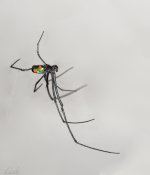You are using an out of date browser. It may not display this or other websites correctly.
You should upgrade or use an alternative browser.
You should upgrade or use an alternative browser.
Post your spiders
- Thread starter Bukitimah
- Start date
This tiny (body only about 3mm long) Orchard Web spider has a web right outside the front door. The neon colors on their abdomen are amazing! A 55mm f/2.8 Micro Nikkor and ring flash did the trick!
View attachment 322441
Alas, when I went out the next day, this beautiful little arachnid was gone without a trace. :sorrow:
Is this a Hobo Spider? They build funnel webs just like the very dangerous Funnel Web Spiders in Australia
Robin W
Senior Member
My grandson spotted this spider and asked me to take it's picture. My camera was in the air conditioning at the time and when I brought it out the lens kept fogging up, hence the lack of sharpness. But I love the shadow it threw. This spider was very little but the shadow makes him look quite frightening.

Robin W
Senior Member
These 4 photos are of a Fishing Spider. Fishing spiders, such as the brownish-gray fishing spider, Dolomedes tenebrosus, are often found near or in water, but they also hunt in forests and, apparently, on my camper. Dolomedes do not build webs to capture prey. They roam freely and consume a variety of animals in and on water and on land. They can run across the surface of a pool or stream and actually dive and remain submerged for several minutes while they hunt and capture small fish and tadpoles using sharp claws and powerful fangs. Fishing spiders belong to a clan known as nursery web spiders, so called for their habit of building a small web to serve as the hatching place for tiny spiderlings that emerge from an egg sac.




Friggs
Senior Member
I was at one of my favorite places to take bird photos at. After I was shooting a goldfinch I happened to look up and saw this spider wrapping up this dragonfly that got caught in the web. It went around it a few times and the dragonfly tried to flap its wings to get free. But to no avail. The spider then pulled it up to a leaf in a tree limb close by. Interesting to watch. I did not stick around to see it eat it.
 08212020-686-3 by Bill Friggle Photography, on Flickr
08212020-686-3 by Bill Friggle Photography, on Flickr
 08212020-686-3 by Bill Friggle Photography, on Flickr
08212020-686-3 by Bill Friggle Photography, on Flickr



